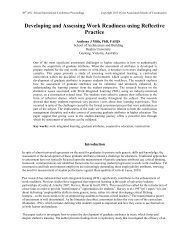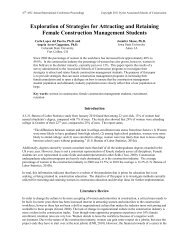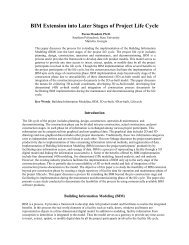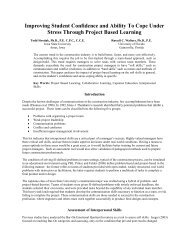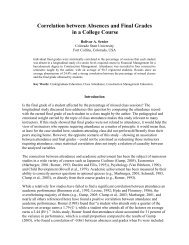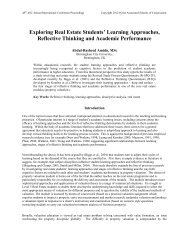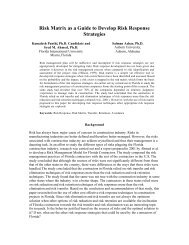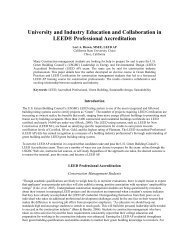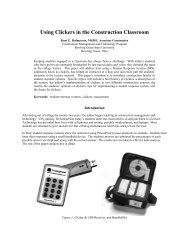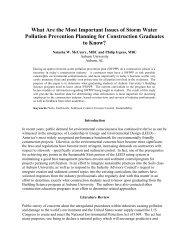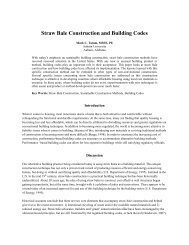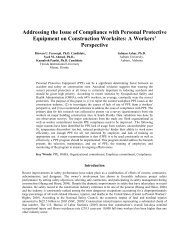The Construction History Textbook Project: A Case Study of ...
The Construction History Textbook Project: A Case Study of ...
The Construction History Textbook Project: A Case Study of ...
Create successful ePaper yourself
Turn your PDF publications into a flip-book with our unique Google optimized e-Paper software.
<strong>The</strong> <strong>Construction</strong> <strong>History</strong> <strong>Textbook</strong> <strong>Project</strong>: A <strong>Case</strong><br />
<strong>Study</strong> <strong>of</strong> Scholarship and <strong>Study</strong> Abroad<br />
Linda Cain Ruth, A.I.A.<br />
Auburn University<br />
Auburn, Alabama<br />
Often, a faculty member‟s excitement over the opportunity to organize and lead a study abroad<br />
program is <strong>of</strong>fset by justifiable concern that necessary research work has to be put on hold. This<br />
case study highlights a major research initiative known as the <strong>Construction</strong> <strong>History</strong> <strong>Textbook</strong><br />
<strong>Project</strong> that is an effort to develop and publish a textbook for the purpose <strong>of</strong> teaching the history<br />
<strong>of</strong> construction to college freshmen. This <strong>Project</strong> used a study abroad program to provide its<br />
initial research effort. This approach is unique in that the study abroad experience was not a standalone<br />
activity; it was an integral part <strong>of</strong> a larger research initiative. Even after the completion <strong>of</strong><br />
the <strong>Study</strong> Abroad Program, the further development and refinement <strong>of</strong> the textbook, as well as<br />
additional research, is continuing. <strong>The</strong> <strong>Construction</strong> <strong>History</strong> <strong>Textbook</strong> <strong>Project</strong> has received<br />
national recognition for its successful combination <strong>of</strong> international and U.S. travel and study,<br />
undergraduate research, and the development <strong>of</strong> writing skills.<br />
Key Words: study abroad, undergraduate, research, construction history, textbook<br />
Introduction<br />
<strong>The</strong> link between scholarship and the 2008 Summer <strong>Study</strong> Abroad Program <strong>of</strong> the McWhorter School <strong>of</strong> Building<br />
Science at Auburn University started with a need. <strong>The</strong> need presented itself in the course “<strong>History</strong> and Introduction<br />
to <strong>Construction</strong>”, the first course within the School‟s curriculum. <strong>The</strong> class is <strong>of</strong>fered both semesters <strong>of</strong> the academic<br />
year and average enrollment per semester is 150 students. It is a required course for Building Science majors, but is<br />
available as an elective to all students throughout the University. <strong>The</strong>refore, the class is comprised <strong>of</strong> those students<br />
who have already decided to pursue a pr<strong>of</strong>essional career in the construction industry (90%), those who are<br />
considering declaring or switching majors to pursue such a career (3%), and those who take the class as an elective<br />
and are curious and interested in architecture and the built environment (7%). <strong>The</strong> introduction to construction<br />
portion <strong>of</strong> the class includes introducing students to the major aspects and issues <strong>of</strong> today‟s construction industry;<br />
types <strong>of</strong> constructors and construction companies, the educational path <strong>of</strong> a constructor, different careers and<br />
responsibilities in construction, various project acquisition and delivery methods, and current issues such as the use<br />
<strong>of</strong> building information modeling and sustainability. <strong>The</strong> history component <strong>of</strong> the course surveys significant<br />
milestones and issues in construction technology and project management throughout history and ends with a survey<br />
<strong>of</strong> contemporary architecture and architects to allow students to be conversant on the topic.<br />
It was during the preparation <strong>of</strong> the course that the need for a textbook that chronicles the history <strong>of</strong> construction<br />
became evident. In 2007, Bill Addis, a consulting engineer wrote and published Building: 3000 Years <strong>of</strong> Design<br />
Engineering and <strong>Construction</strong> (Addis, 2007). However, while the book documents an impressive amount <strong>of</strong><br />
research, the presentation <strong>of</strong> the material is not in a textbook format and is best understood by the advanced student<br />
or practitioner in engineering. <strong>The</strong> book is not appropriate for use at the undergraduate level. <strong>The</strong> textbooks that<br />
most closely address the topic at a level that is appropriate to the class are architectural history books. <strong>The</strong>se<br />
textbooks describe in great detail the architects‟ thought process behind the design <strong>of</strong> a building, the reasoning<br />
behind its aesthetics, and an analysis <strong>of</strong> its context and design. <strong>The</strong> construction <strong>of</strong> the building, if addressed at all,<br />
is done so in a parenthetical manner and is not the main focus <strong>of</strong> the text.<br />
Architectural history books also document well the architectural heroes throughout time. But rarely are the names <strong>of</strong><br />
the builders mentioned. Perhaps this is because the names <strong>of</strong> the builders <strong>of</strong> many <strong>of</strong> the world‟s most significant<br />
structures are not known. But, this lack <strong>of</strong> knowledge only serves to highlight the fact that while architecture
students are taught about the legacy <strong>of</strong> their pr<strong>of</strong>ession and those that contributed to it, construction education<br />
students are not provided with the same sense <strong>of</strong> heritage and connection with builders throughout history. Yet, for<br />
over 4,000 years, builders have encountered and resolved the same issues; preparing a site for construction, having<br />
materials at the jobsite when they are needed, supervising labor, scheduling activities, and adapting when things do<br />
not go as planned. <strong>The</strong> problems are the same; it is the solutions that have changed with time and technology.<br />
Method<br />
<strong>The</strong> opportunity to tackle the lack <strong>of</strong> a construction history textbook began with the 2008 BSCI Summer <strong>Study</strong><br />
Abroad Program. Since the summer <strong>of</strong> 2000, Auburn‟s Building Science program has conducted eight summer study<br />
abroad experiences and has become a leader in providing students with opportunities to travel and study abroad.<br />
(Kramer, 2004). Two faculty members, one being the lead faculty and the other assisting, direct each Program.<br />
Although several graduate students have been able to participate in the Programs, the majority <strong>of</strong> students are in the<br />
last semester <strong>of</strong> their undergraduate degree and receive four hours credit for Undergraduate <strong>The</strong>sis and two hours <strong>of</strong><br />
credit for Temporary Structures. <strong>The</strong> lead faculty decides the format for delivery <strong>of</strong> these courses as well as the<br />
focus and requirements for the Undergraduate <strong>The</strong>sis, both <strong>of</strong> which are presented to the faculty for their approval.<br />
It was through the coupling <strong>of</strong> the <strong>Study</strong> Abroad Program with the need <strong>of</strong> a construction history textbook that both<br />
the <strong>Construction</strong> <strong>History</strong> <strong>Textbook</strong> <strong>Project</strong> was begun and the direction <strong>of</strong> the 2008 BSCI Summer <strong>Study</strong> Abroad<br />
Program was established. <strong>The</strong> structure <strong>of</strong> the <strong>The</strong>sis portion <strong>of</strong> the <strong>Study</strong> Abroad Program was that each student be<br />
assigned an iconic architectural structure or building that he or she would visit and research, and then write its<br />
history from the viewpoint <strong>of</strong> a constructor. <strong>The</strong> process was dubbed “deconstructing construction”. <strong>The</strong> student‟s<br />
papers were developed as chapters that are being compiled to create a textbook for use in the Department‟s<br />
freshman-level <strong>History</strong> and Introduction to <strong>Construction</strong> course. Using the <strong>Study</strong> Abroad Program in this manner<br />
allowed for the initial work on the <strong>Construction</strong> <strong>History</strong> <strong>Textbook</strong> <strong>Project</strong> to consist <strong>of</strong> a substantial amount <strong>of</strong><br />
material due to the number <strong>of</strong> students that would be involved.<br />
In the spring <strong>of</strong> 2007, one year before the <strong>Study</strong> Abroad Program, the focus <strong>of</strong> the proposed <strong>Study</strong> Abroad Program<br />
and the work that was to be undertaken by the students to begin the process <strong>of</strong> writing a construction history<br />
textbook was presented to and approved by the Building Science faculty. <strong>The</strong> approval process from Department<br />
Head, to faculty, to University administration came rather easily due, in no small part, to the fact that even apart<br />
from the value <strong>of</strong> the resulting textbook, the process included three activities that are have recently become highly<br />
valued on college campuses throughout the U.S.; international study (Bellamy & Weinberg, 2006), undergraduate<br />
student-faculty collaborative research (CUR, 2005), and the development <strong>of</strong> writing skills (Warner, 2008).<br />
With the necessary approvals, next came the complicated task <strong>of</strong> developing an optimal <strong>Study</strong> Abroad itinerary that<br />
would accomplish the most possible for the <strong>Construction</strong> <strong>History</strong> <strong>Textbook</strong> <strong>Project</strong> while keeping the cost <strong>of</strong> the<br />
<strong>Study</strong> Abroad Program at an acceptable and marketable level. It was decided to organize the contents <strong>of</strong> the<br />
textbook by architectural time periods. This would allow the freshman students to become familiar with the<br />
architectural vocabulary used to describe certain design periods and the related elements <strong>of</strong> each. However, instead<br />
<strong>of</strong> a survey <strong>of</strong> the numerous buildings that fall within each category, the most iconic structure from each time period<br />
was selected and used as the subject for that chapter and its construction described in detail. Due to the limitations<br />
<strong>of</strong> time and cost <strong>of</strong> the <strong>Study</strong> Abroad Program, it was determined that the study <strong>of</strong> construction history in the<br />
development <strong>of</strong> only western civilization could be addressed. Table 1 shows the final periods <strong>of</strong> architectural history<br />
and the iconic structure from each period and its location that have been selected for inclusion in the first edition <strong>of</strong><br />
the <strong>History</strong> <strong>of</strong> <strong>Construction</strong> textbook.<br />
Table 1<br />
Proposed Chapters in First Edition <strong>of</strong> the <strong>Construction</strong> <strong>History</strong> <strong>Textbook</strong> (Chapters not developed as part <strong>of</strong> the<br />
2008 <strong>Study</strong> Abroad Program in italics)<br />
Chapter Architectural Time Period or Issue Iconic Structure Location<br />
1 Neolithic Stonehenge Amesbury, England<br />
2 Mesopotamian Ziggurat <strong>of</strong> Ur Ur, Iraq
3 Egyptian Great Pyramid Giza, Egypt<br />
4 Egyptian Hypostyle Hall at Karnak Luxor, Egypt<br />
5 Early Greek Palace <strong>of</strong> Knossos Knossos (Crete), Greece<br />
6 Greek Parthenon Athens, Greece<br />
7 Roman Colosseum Rome, Italy<br />
8 Roman Pantheon Rome, Italy<br />
9 Byzantine St. Mark‟s Basilica* Venice, Italy<br />
10 Romanesque Tower <strong>of</strong> Pisa Pisa, Italy<br />
11 Gothic Cathedral <strong>of</strong> Notre Dame Paris, France<br />
12 Gothic Borgund Church Norway<br />
13 Early Renaissance Dome <strong>of</strong> the Florence Cathedral Florence, Italy<br />
14 Late Renaissance Villa Rotunda Vicenza, Italy<br />
15 Baroque/Rococo Piazza <strong>of</strong> St. Peter‟s Basilica Vatican City, Italy<br />
16 Early Industrial Revolution Crystal Palace London, England<br />
17 Late Industrial Revolution Eiffel Tower Paris, France<br />
18 1900‟s Modern Sagrada Familia Barcelona, Spain<br />
19 Arts & Crafts Fallingwater Bear Run, Pennsylvania<br />
20 Skyscrapers Empire State Building New York City, New York<br />
21 Modern Palazetto del Sport Rome, Italy<br />
22 Post Modern Pompidou Centre Paris, France<br />
23 Contemporary Millenium Dome London, England<br />
24 Digital Guggenheim Museum Bilbao, Spain<br />
25 Green Building 30 St. Mary Axe London, England<br />
* Hagia Sophia in Istanbul, Turkey was originally selected to represent the Byzantine period, but was replaced in an<br />
effort to reduce the cost <strong>of</strong> the <strong>Study</strong> Abroad trip.<br />
It was determined that an 8-week period <strong>of</strong> travel abroad would optimize the number <strong>of</strong> sites that could be visited<br />
while also keeping the cost <strong>of</strong> the Program within a marketable range. A Work Week in the middle <strong>of</strong> the <strong>Study</strong><br />
Abroad Program where the group was stationary and did not travel was also included for four reasons. Foremost, it<br />
allowed the students to settle in and accomplish a great deal <strong>of</strong> writing that was difficult to accomplish while<br />
traveling. Secondly, through a Memorandum <strong>of</strong> Understanding between Auburn University and Franklin University<br />
in Lugano, Switzerland, classroom space and accommodations were provided. <strong>The</strong> classroom allowed for the<br />
completion <strong>of</strong> the academic requirements for the Temporary Structures course that the students were getting credit<br />
for in addition to their Special <strong>The</strong>sis credit. Thirdly, the Work Week, while certainly not to the degree <strong>of</strong> a<br />
stationary <strong>Study</strong> Abroad Program, allowed the students to get a sense <strong>of</strong> living in a foreign locale. <strong>The</strong> Franklin<br />
College accommodations provided a kitchenette in each student room. This allowed the students the opportunity to<br />
shop for groceries and develop the routine <strong>of</strong> a resident. Lastly, the Work Week allowed for the textbook‟s Graphic<br />
Designer, Ross Heck, to join the group and begin to produce schematic layouts for the chapters based on the type <strong>of</strong><br />
information and graphics that the students were developing. Following the Work Week, students were given a week<br />
for independent travel before resuming the final portion <strong>of</strong> the <strong>Study</strong> Abroad Program. Table 2 shows the final 8-<br />
week itinerary that was developed and the structures that were researched in each location. <strong>The</strong> final itinerary was a<br />
synthesis <strong>of</strong> numerous factors including the location <strong>of</strong> the target buildings to be studied, cost, and the inclusion <strong>of</strong><br />
the Work Week and independent travel week.<br />
Table 2<br />
Final Itinerary <strong>of</strong> the 2008 Summer <strong>Study</strong> Abroad Program and the Buildings Researched at Each Location<br />
Dates Location Research Focus<br />
May 25 – May 28 Cairo, Egypt Great Pyramid<br />
May 29 – May 31 Luxor, Egypt Hypostyle Hall at Karnak Temple<br />
June 1 – June 4 Athens, Greece Parthenon<br />
June 5 – June 7 Heraklion (Crete), Greece Palace <strong>of</strong> Knossos<br />
June 8 – June 12 Rome (& Vatican City), Italy Colosseum<br />
Pantheon
Piazza <strong>of</strong> St. Peter‟s Basilica<br />
Palazetto del Sport<br />
June 13 – June 16 Florence (& Pisa), Italy Dome <strong>of</strong> the Florence Cathedral<br />
Tower <strong>of</strong> Pisa<br />
June 17 – June 21 Venice (& Vicenza), Italy St. Mark‟s Basilica<br />
Villa Rotunda<br />
June 22 – 27 Lugano, Switzerland Work Week<br />
June 28 – July 4 ----- Independent Week<br />
July 5 – July 9 Barcelona, Spain Sagrada Familia<br />
July 10 – July 12 Bilbao, Spain Guggenheim Museum<br />
July 13 – July 19 Paris, France Notre Dame<br />
Eiffel Tower<br />
Pompidou Centre<br />
Student Selection<br />
In addition to the large amount <strong>of</strong> time spent developing the research project and the itinerary, and extraordinary<br />
amount <strong>of</strong> time was dedicated to the process <strong>of</strong> selecting the students to participate. To allow students and their<br />
parents as much time as possible to contemplate the student‟s participation and plan for its financial implications,<br />
the <strong>Study</strong> Abroad Program was presented to prospective students in the Spring 2007 semester, four semesters before<br />
the start <strong>of</strong> the trip. Although minor modifications were still being made to the itinerary, the focus <strong>of</strong> working on the<br />
<strong>Construction</strong> <strong>History</strong> <strong>Textbook</strong> <strong>Project</strong> and the cost <strong>of</strong> the Program, with a comfortable contingency, were provided.<br />
Providing students with this information at such an advanced date prior to travel allowed them and their families to<br />
thoughtfully consider and plan for the financial and educational ramifications <strong>of</strong> participation.<br />
At the start <strong>of</strong> the following Fall 2007 semester, a competitive five-stage process <strong>of</strong> selecting students began. Each<br />
stage and its respective value in the process are listed in Table 3.<br />
Table 3<br />
Process <strong>of</strong> Selection <strong>of</strong> Students for 2008 Summer <strong>Study</strong> Abroad Program<br />
Stage Activity Value<br />
1 Faculty Approval 30%<br />
2 Mini-sleuthing Exercise 25%<br />
3 Extemporaneous Writing Exercise 20%<br />
4 GPA 15%<br />
5 Interview 10%<br />
First, students that were interested in the Program were asked to send an email to the Director that indicated their<br />
interest and included the letter grades earned in the Building Science courses completed to date. Currently, in the<br />
Building Science curriculum at Auburn the last semester undergraduate <strong>The</strong>sis course is structured to be a synthesis<br />
<strong>of</strong> all the material learned from previous Building Science courses. Students who, by their performance in previous<br />
coursework in the curriculum have shown an understanding <strong>of</strong> the content, can be considered by the faculty for a<br />
Special <strong>The</strong>sis project that allows the student to work with a faculty sponsor on a project that seeks new knowledge<br />
or is an application <strong>of</strong> knowledge distinctly different than that used in the traditional thesis. <strong>The</strong> work completed as<br />
part <strong>of</strong> one <strong>of</strong> the <strong>Study</strong> Abroad Programs is viewed as a Special <strong>The</strong>sis and therefore, interested students are<br />
presented to the full Building Science faculty for discussion as to whether it is felt that any <strong>of</strong> the students would<br />
benefit more from the School‟s traditional on-campus <strong>The</strong>sis process or to determine if there were any concerns<br />
regarding a student‟s collegiality or maturity based on the student‟s performance in Building Science classes. Of the<br />
nineteen students that expressed interest in participating in the 2008 <strong>Study</strong> Abroad Program, seventeen received<br />
unanimous approval by the faculty and two received partial approval; one due to concerns <strong>of</strong> his ability to function<br />
well in a group setting and the other due to academic concerns.
<strong>The</strong> second step toward selection was a Mini-Sleuthing Exercise. This was an activity to gauge each student‟s ability<br />
to conduct research. Each student was assigned an iconic structure in the U.S. and asked to research and write a<br />
report on its construction with a special focus on the people, process, materials, and equipment. <strong>The</strong> Exercise served<br />
as a smaller version <strong>of</strong> the type <strong>of</strong> research and writing that would be required for the <strong>The</strong>sis. Each student‟s paper<br />
was evaluated for its quality <strong>of</strong> writing and the variety <strong>of</strong> sources listed in the Bibliography, with the students who<br />
assessed library books and databases being scored higher than those that used only internet sources.<br />
In order to assess the amount <strong>of</strong> editing for style that would be required <strong>of</strong> each student‟s work, the third stage<br />
toward selection consisted <strong>of</strong> an extemporaneous writing assignment. <strong>The</strong> student candidates were given two hours<br />
to answer the question, “Why do you want to have a <strong>Study</strong> Abroad experience and what attributes or skills do you<br />
have that will be a positive contribution to the group and enhance the group‟s experience?” <strong>The</strong> replies mirror those<br />
found in other studies <strong>of</strong> why college students wish to participate in study abroad programs; namely, because it is a<br />
once-in-a-lifetime opportunity, enhances future career opportunities, and an opportunity to experience different<br />
cultures. However, those students that mentioned being part <strong>of</strong> the <strong>Construction</strong> <strong>History</strong> <strong>Textbook</strong> <strong>Project</strong> were<br />
scored higher than those that did not. An interest in the work that was to be done was seen as critical to elevating the<br />
quality <strong>of</strong> work that would be generated as well as <strong>of</strong>fsetting the fatigue factor that <strong>of</strong>ten develops when people<br />
travel together for extended times. <strong>The</strong>se essays were blind-reviewed and scored by the Director and the other two<br />
faculty members that would serve as assistant faculty during the eight-week travel time. All three scores were<br />
combined to generate each student‟s final score on this portion <strong>of</strong> the application process.<br />
<strong>The</strong> fourth stage <strong>of</strong> the selection process was the evaluation <strong>of</strong> each student‟s current overall GPA. <strong>The</strong> School‟s<br />
Academic Advisor provided this information. <strong>The</strong> fifth component <strong>of</strong> the selection process was a personal interview<br />
with the students to appraise their communication skills, overall attitude, and demeanor.<br />
Of the nineteen students who completed each portion <strong>of</strong> the selection process, fifteen were chosen without<br />
reservation and two were selected after a second meeting to address concerns that were raised during the<br />
extemporaneous writing exercise and the interview process. Two students were not selected to participate; one due<br />
to poor writing skills and one due to a lack <strong>of</strong> interest in the research project. <strong>The</strong> final group <strong>of</strong> twenty was<br />
composed <strong>of</strong> seventeen undergraduate students (fourteen males and three females), one undergraduate student, the<br />
Director, and two assisting faculty members that would each travel with the group for four weeks, swapping places<br />
with each other midway through the trip.<br />
After being selected, each student was asked to submit their top three choices <strong>of</strong> buildings that they would like to<br />
research. This information, along with the scores they earned from the writing portions <strong>of</strong> the selection process<br />
(Stage 2 and Stage 3) were used to pair the students with the structure that they would be assigned for their Special<br />
<strong>The</strong>sis. Higher pr<strong>of</strong>ile buildings, such as the Pantheon and the Parthenon, were assigned to the best writers.<br />
Preparation<br />
A preparatory class for two credit hours was a mandatory requirement <strong>of</strong> the students for the Spring semester<br />
immediately prior to travelling. During this time, skills for travel in Europe, such as reading subway maps, security<br />
precautions, and learning basic words in each <strong>of</strong> the languages that would be encountered, were taught. Students<br />
were also required to read R. A. Scotti‟s Basilica: <strong>The</strong> Splendor and the Scandal – Building St. Peter’s (Scotti,<br />
2006) as it would prepare them for their visit to St. Peter‟s and because the book reflected the type <strong>of</strong> construction<br />
information that they would be including in their chapters. Preliminary research and literature reviews for the<br />
Special <strong>The</strong>sis projects were also conducted.<br />
During this time and later during the Work Week in Switzerland, opportunities to create sidebars were identified and<br />
were added to the content <strong>of</strong> each chapter. <strong>The</strong> chapter content provided a springboard to sidebars that link the<br />
historic project to basic modern day construction activities and issues and expand on certain caveats <strong>of</strong> each project<br />
that students found <strong>of</strong> particular interest and worthy <strong>of</strong> elaboration. <strong>The</strong> proposed sidebars are listed in Table 4.<br />
Table 4<br />
Iconic Buildings and Chapter Sidebar Topics
Building<br />
Great Pyramid<br />
Hypostyle Hall at Karnak Temple<br />
Palace <strong>of</strong> Knossos<br />
Parthenon<br />
Colosseum<br />
Pantheon<br />
St. Mark‟s Basilica<br />
Tower <strong>of</strong> Pisa<br />
Notre Dame<br />
Dome <strong>of</strong> the Florence Cathedral<br />
Villa Rotunda<br />
Piazza <strong>of</strong> St. Peter‟s Basilica<br />
Eiffel Tower<br />
Sagrada Familia<br />
Palazetto del Sport<br />
Pompidou Centre<br />
Guggenheim Bilbao<br />
Sidebars<br />
Development <strong>of</strong> the Pyramid Shape<br />
Imhotep & Snefru<br />
Estimating Earthwork<br />
Legend <strong>of</strong> the Minotaur<br />
Passive Sustainability<br />
Classical Orders<br />
Tale <strong>of</strong> the Elgin Marbles<br />
Reading Orthographic Drawings<br />
<strong>History</strong> <strong>of</strong> Concrete<br />
<strong>Construction</strong> <strong>of</strong> Elevated Slabs<br />
Historic Stadium „Firsts‟<br />
Development <strong>of</strong> the Dome<br />
Other Notable Roman <strong>Construction</strong>s<br />
Temporary Structures<br />
Key Features <strong>of</strong> Byzantine Architecture<br />
Other Famous Byzantine Buildings<br />
Venice in Peril<br />
Building Foundation Typologies<br />
Key Feature <strong>of</strong> Romanesque Architecture<br />
Other Famous <strong>Construction</strong> Failures<br />
Soil Typologies<br />
Key Features <strong>of</strong> Gothic Architecture<br />
Other Famous Gothic Buildings<br />
<strong>The</strong> Guild System<br />
<strong>The</strong> <strong>History</strong> <strong>of</strong> <strong>Project</strong> Delivery Systems<br />
Key Features <strong>of</strong> Renaissance Architecture<br />
Brunelleschi<br />
Famous Domes<br />
Antoni Palladio to Thomas Jefferson<br />
Quantity Take-Off and Pricing<br />
Key Features <strong>of</strong> Baroque & Rococo Architecture<br />
Other Famous Baroque Buildings<br />
Change Orders<br />
Modern Surveying<br />
Gustave Eiffel<br />
Other Famous Iron Structures<br />
<strong>History</strong> <strong>of</strong> Steel<br />
Antoni Gaudi<br />
Other famous Arts & Crafts and Art Nouveau Buildings<br />
Jobsite Safety<br />
Other Famous Thin-Shelled Concrete Structures<br />
Other Famous Structure-As-Architecture Buildings<br />
<strong>The</strong> Importance <strong>of</strong> MEP<br />
Frank Gehry<br />
Building Information Modeling<br />
<strong>Study</strong> Abroad Program Enhancements<br />
Several activities and events served to enhance the 2008 Summer <strong>Study</strong> Abroad Program and enrich the students‟<br />
experience beyond the task <strong>of</strong> research and writing. <strong>The</strong>se included meetings with scholars and experts, field trips,<br />
and the use <strong>of</strong> students as tour guides.
Meetings with scholars<br />
In several locations, either the student researcher or the Program Director arranged for meetings with scholars and<br />
experts that were well versed in the history <strong>of</strong> the building being researched. <strong>The</strong>se included Engineer Giuliano<br />
Molon <strong>of</strong> Insula in Venice, Italy; Cesar Caicova Gomez Moran, Production Architect and <strong>Construction</strong> Manager <strong>of</strong><br />
the Guggenheim Museum in Bilbao, Spain; Davide Vitali, Architect and former colleague <strong>of</strong> Pier Luigi Nervi; Jordi<br />
Fauli I Oller, Lead Architect and <strong>Construction</strong> Manager <strong>of</strong> Sagrada Familia; Nabil Labib, Architect and<br />
Egyptologist; and internationally renowned, Dr. Zahi Hawass, Secretary General <strong>of</strong> the Supreme Council <strong>of</strong><br />
Egyptian Antiquities. Dr. Hawass provided the group with full access to the Sphinx, to the interior <strong>of</strong> the Great<br />
Pyramid, and to the excavations <strong>of</strong> the recently discovered Workers Village adjacent to the Giza Plateau Pyramids<br />
that have not been opened for public viewing.<br />
Field Trips<br />
Apart from the trips made as a group to each <strong>of</strong> the buildings being researched for the textbook, additional field trips<br />
were arranged to the Gotthard Base Tunnel, the longest and deepest tunnel in the world being constructed by<br />
Hochtief and partners in Switzerland; the headquarters <strong>of</strong> the Organization for Economic Cooperation &<br />
Development (OECD) in Paris being constructed by GEMO International, one <strong>of</strong> France‟s largest construction<br />
companies, the Rome Subway Expansion – Line C being constructed by Salini Construttori in association with<br />
RockSoil S.p.A.; and the Phillip Morris Manufacturing Plant being constructed by <strong>The</strong> Arab Contractors in Cairo,<br />
Egypt. Apart from one field trip that was scheduled by one <strong>of</strong> the students, these field trips were arranged by<br />
contacts made by colleagues in the construction management programs at Georgia Tech (Pr<strong>of</strong>essor Brian Bowen)<br />
and Southern Polytechnic University (Pr<strong>of</strong>essor Ismail Basha).<br />
Student Tour Guides<br />
Instead <strong>of</strong>, and in some cases in addition to, hiring tour guides at the sites <strong>of</strong> the buildings being studied, the student<br />
researchers were required to serve as tour guides for their fellow students during the group‟s visit to the building that<br />
they were researching. This insured that students were provided information about the construction <strong>of</strong> the building<br />
instead <strong>of</strong> only the historical and architectural history that is usually provided by hired tour guides.<br />
Results<br />
<strong>The</strong> <strong>Construction</strong> <strong>History</strong> <strong>Textbook</strong> <strong>Project</strong> and the <strong>Study</strong> Abroad Program that provided its initial momentum<br />
produced both a research initiative and a study abroad program with many unique and successful caveats that<br />
enhanced the experience for the faculty, the study abroad program, the research, and the students. <strong>The</strong> postexperience<br />
comments from students regarding the benefits that they received as part <strong>of</strong> their participation in the<br />
2008 Summer <strong>Study</strong> Abroad Program were similar in nature to those <strong>of</strong> other college students that have had an<br />
opportunity for foreign travel and study. <strong>The</strong>y appreciated the experience as a once-in-a-lifetime chance and felt<br />
they had grown as world citizens through their knowledge and value <strong>of</strong> cultures that are different than their own.<br />
However, in addition to the comments regarding the international travel, many expressed pride in knowing that their<br />
Senior <strong>The</strong>sis would be useful beyond their graduation as a way <strong>of</strong> giving back to the School.<br />
<strong>The</strong> <strong>Construction</strong> <strong>History</strong> <strong>Textbook</strong> <strong>Project</strong> has received a large amount <strong>of</strong> attention within the College <strong>of</strong><br />
Architecture Design and <strong>Construction</strong> at Auburn and in numerous publications <strong>of</strong> the University. <strong>The</strong> <strong>Project</strong> also<br />
received national attention when it was featured in Engineering News Record’s 2008 special issue on construction<br />
education.<br />
Future Research<br />
<strong>The</strong> ending <strong>of</strong> the 2008 Summer <strong>Study</strong> Abroad Program did not represent the end <strong>of</strong> the <strong>Construction</strong> <strong>History</strong><br />
<strong>Textbook</strong> <strong>Project</strong>. In the Fall <strong>of</strong> 2008, three more students were selected to participate in a <strong>Study</strong> Abroad Experience<br />
embedded within the academic semester. <strong>The</strong> following Spring 2009 semester, three more students were selected to<br />
write for the <strong>Construction</strong> <strong>History</strong> <strong>Textbook</strong> <strong>Project</strong>. However, the work <strong>of</strong> this latter group focused on the<br />
contributions to construction that are part <strong>of</strong> America‟s history. <strong>The</strong>refore, the travel was not abroad, but to U.S.
destinations. It was also during this last effort that a trial <strong>of</strong> having a student research the construction <strong>of</strong> a building<br />
that no longer exists was tried. It is the only chapter to date that has been written by a student that has not visited the<br />
building or site. It was determined that this was a major detriment to the student‟s work. <strong>The</strong> research and writing<br />
became more <strong>of</strong> an academic process and seemed to lack the passion that was in the writing <strong>of</strong> those students who<br />
were able to visit their projects. Two final chapters remain to be written in order to complete the first edition <strong>of</strong> the<br />
textbook which will focus on the development <strong>of</strong> Western civilization. Because one <strong>of</strong> the remaining projects is in<br />
Iraq, visiting that project will also not be possible. Instead <strong>of</strong> a Special <strong>The</strong>sis project, it is planned that the<br />
development <strong>of</strong> this chapter will be a collaborative effort <strong>of</strong> the freshmen students in the <strong>History</strong> and Introduction to<br />
<strong>Construction</strong> course. <strong>The</strong> visit and research for the lone remaining project is planned to occur in the Fall 2010<br />
semester. A listing <strong>of</strong> the projects that have been completed or are planned outside the venue <strong>of</strong> the 2008 Summer<br />
<strong>Study</strong> Abroad Program are shown in Table 5.<br />
Table 5<br />
Chapters Completed Outside <strong>of</strong> the 2008 Summer <strong>Study</strong> Abroad Program<br />
Venue Dates Location Research Focus<br />
Fall 2008 Embedded<br />
<strong>Study</strong> Abroad<br />
Oct. 10 - 16 London, England Millennium Dome<br />
30 St. Mary Axe<br />
Amesbury, England<br />
Stonehenge<br />
Spring 2009<br />
Embedded Travel<br />
March 28 – 31 New York City, New York Empire State Building<br />
Crystal Palace (London)*<br />
April 1 – April 2 Bear Run, Pennsylvania Fallingwater<br />
Future In-class research & writing project** Ziggurat <strong>of</strong> Ur<br />
Borgund, Norway<br />
Borgund Stave Church<br />
* As this building was lost to fire in 1936, the student researched its construction, but was unable to visit the site.<br />
** As this structure is located in the Dhi Qar Province <strong>of</strong> Iraq, travel to the site is not possible. It is anticipated that<br />
this chapter will be developed as part <strong>of</strong> a class project.<br />
It is planned that the <strong>Construction</strong> <strong>History</strong> <strong>Textbook</strong> <strong>Project</strong> will produce not one, but a series <strong>of</strong> several textbooks<br />
with each focusing on a different time period, geographic region, or construction method. Future editions covering<br />
iconic civil engineering projects such as dams, tunnels, and bridge projects, as well as editions that will focus on the<br />
architectural and construction heritage found in Eastern and pre-Columbian cultures are planned.<br />
References<br />
Addis, B. (2007). Building: 3000 years <strong>of</strong> design engineering and construction. London: Phaidon.<br />
Bellamy, C. & Weinberg, A. (2006, Fall). Creating global citizens through study abroad. Connection: <strong>The</strong> Journal <strong>of</strong><br />
the New England Board <strong>of</strong> Higher Education, 21(2), 20-21.<br />
Carsen, D. (2008, October 27). Auburn University Students Tackle Mission: No Class Text? Write Your Own.<br />
Engineering News Record 261(13), 34-35.<br />
Council on Undergraduate Research (2005). Joint statement <strong>of</strong> principles in support <strong>of</strong> undergraduate research,<br />
scholarship, and creative activities. [WWW document]. URL http://www.cur.org/SummitPosition.html.<br />
Kramer, S. (2004). An Alternative Senior Capstone Class: Experiential Learning & European <strong>Construction</strong>.<br />
Associated Schools <strong>of</strong> <strong>Construction</strong>: International Proceedings <strong>of</strong> the 40 th Annual Conference, [WWW document].<br />
URL http://ascpro0.ascweb.org/archives/2004/Kramer04a.htm.<br />
Scotti, R. A. (2006). Basilica: <strong>The</strong> splendor and the scandal: Building St. Peter’s. New York: Viking.<br />
Warner, F. (2008, Nov/Dec). Improving communication is everyone‟s responsibility. Change, 40(6), 26-35.



